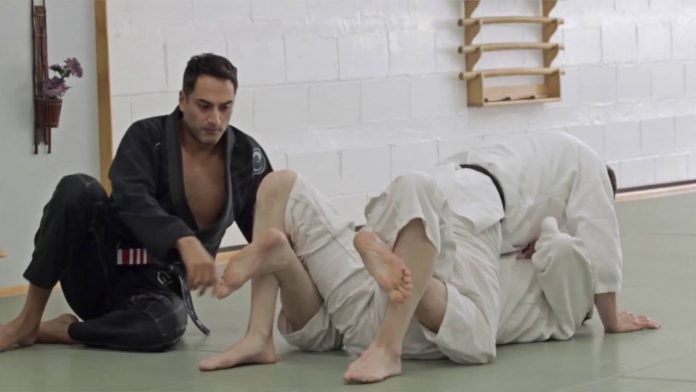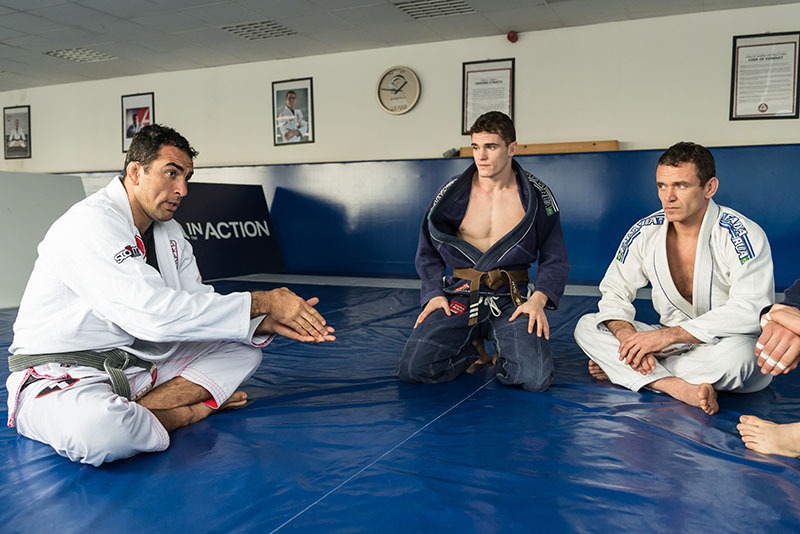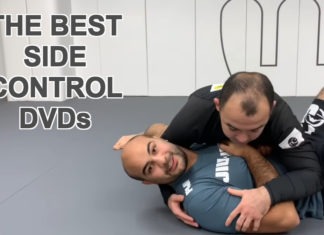
Most Brazilian Jiu-Jitsu academies have a similar structure to their classes. Actually, it is a concept that is not dissimilar to other grappling martial arts. While the class structure is very important for the continuous progress of students, so are different BJJ classes. A kids class, for example, shouldn’t be the same as an adult class. Even among adult classes, there should be a clear distinction between different levels. The usual structure calls for beginner and advanced classes. Sometimes people also throw in a specific competitors-only class, dedicated to tournament preparation. However, lots of academies have nothing to offer people that come through the door apart from jumping straight into a beginners class.
The structure that most BJJ classes follow is all about giving students the opportunity to progress in a structured and methodical fashion. There is a reason why instructors pay so much attention to maintaining the structure. You won’t see many instructors promoting open mat classes over technical ones. The reason behind this is simple. As useful and crucial as rolling is for Jiu-Jitsu, it is also not a good learning tool. At least not in a technical manner. There is a reason why most schools do not elt complete beginners roll live straight away, but more on that later. For now, let’s focus on complete beginners and how class structure affects their perception of the sport as well as their eventual progress.
Incorporating the concept of an introductory class into your academy is going to take some work. It requires a lot of dedication and planning but it offers lots in return. First and foremost you’ll offer you, potential members, the absolute best way of learning what Jiu-Jitsu is. next, you’ll be able to precisely present your own brand of Brazilian Jiu-Jitsu, as well as your philosophy. Also, you’ll be able to increase the number of new students significantly, due to the fact that you’re starting off with very clear instructions and giving individual attention to new students. There are many ways to incorporate an intro lesson or lessons among your BJJ classes on a weekly basis.
The very basics of Brazilian Jiu-Jitsu are perfectly laid out in the “Foundations of Brazilian Jiu-Jitsu” DVD set by Bernardo Faria. It is the perfect DVD instructional for a new student to help fill in the gaps from training.
The Concept Of An Intro Class
When I first walked into a Brazilian Jiu-Jitsu academy, I got to roll straight away. Ok, it wasn’t right from the door, but it didn’t take long. After a short technical demonstration, it was all about rolling. The coach was a blue belt, and the academy was just starting. The few of us that were there, learned the hard way that there are far better ways of introducing someone to Jiu-Jitsu. That is why now, we have the intro class as a mandatory first experience for any new student.
What is the concept of an intro BJJ class? The best way to look at it is as a private class with new students, where you slowly and very methodically demonstrate what BJJ is. The reason the intro class is very similar to a private is that you will rarely have more than a few students in each one.
Intro BJJ classes need to be held in different time slots than regular classes. Otherwise, whatever is happening in the gym is going to take away the attention of the new students. An intro class is going to require a different structure from normal ones. It also takes some preparation as well. Namely, in Gi academies (which most academies out there are), you’ll need to have spare clean Gis to offer to new students. Wearing a Gi makes their first experience much more different and more exciting.
The goal of the intro class is to make students see that they can do Jiu-Jitsu and how fun it can be. For that, remember to be friendly, stick to demonstrating basic but effective things and do everything along with the students. The intro class needs to be a positive and encouraging experience that makes students want to come back.
1. Intensity And Length
To begin with, make sure to keep the length of the class at around thirty minutes. Most new students are usually not in shape to go through more. Furthermore, if you do an hour-long class you’ll both exhaust them and give them too much information. So keep it short and sweet, keep it active but do not go overboard on the intensity.
Start the class by providing new students with a Gi and help them with tying the belt. Starting their first class ina clean uniform is going to do wonders for their enthusiasm.
2. Simple Warm-Up

3. Movement
Some specific movement patterns should be the first thing you demonstrate after the warm-up. Unlike regular BJJ classes, stick to the simplest patterns in an intro class. Those are the hip escape and the bridge. Put things into perspective, showing students how these work practices, but have them do the movements without a partner. Instead, make sure you give them precise and detailed instruction on every step o the movement. Actually, break the movement up into a few steps and coach them all the way.
4. Self-Defense
PResent Brazilian Jiu-Jitsu as a sport that has effective self-defense applications. Some people are going to sing up for this part only, and even those that don’t do not mind learning it. Do not try and go over complicated with self-defense things. Talk about distance, break falls and getting back up to the feet safely. If you notice that students are more advanced than that, or have some previous knowledge, demonstrate how the clinch works as well.
As far as groundwork goes, go for something simple that you can explain in the 30 minute time frame. A quick armlock from knee on belly or Americana from the mount are perfect techniques to introduce prospective students to what BJJ classes have to offer.
5. Tapping
While on the subject of submissions, make sure you really clear up what they are and how they work in training. Demonstrate tapping by letting a student get you in a submission, and explain the concept behind it. Make sure new students know that they can stop at any time, regardless if they’re in a submission hold or not, just by tapping or saying stop. having such a failproof safety network makes people feel comfortable with training a martial art like Brazilian Jiu-Jitsu.
6. Putting It All Together
Finally, try and put everything together for the students. Starting with break falls and getting back up and to the ground, via a simple takedown (trips work best here) where they finish from knee on belly or mount. Have them repeat the sequence a few times so that they see how different parts of BJJ connect as a whole.
7. Chat
Finish the intro class with a chat with the new students. Expect lot so questions and be ready to answer them in a simple yet informative fashion. Make sure the students have a pleasant first experience and are ready to come back for more. Finally, show them to the dressing rooms and great them before they leave the Academy.
Adding The Intro To Your BJJ Classes

Also, explain the curriculum to them while the class is warming-up and give them an insight into the class structure before you start with the beginners class. Having an organized methodology tends to give people a positive impression of the Academy. They’ll know that they’re safe and that learning is guaranteed when everything is organized in such a fashion.
Finally, if those slots are not really available, an open mat is also a good thing for new students to see right after their first class. Make sure, however, that you stay by their side and explaining what rolling is all about and how it works. Also, let them know that they’ll only be doing position sparring for a while until they get the hang of things. Have them see a couple of students do a position sparring drill, so they have a reference.
OSS Meaning: Discover Its Origin, Usage, And Purport In Martial Arts


![Darce Choke Encyclopedia – Origins, Mechanics and Variations [2025] BJJ, choke, Brabo, BJJ Darce Choke, D'arce Choke, Darce BJJ Choke](https://bjj-world.com/wp-content/uploads/2017/11/JungPoirierLeeYahoo-218x150.jpg)









![Slicin’ Calves Mikey Musumeci DVD Review [2025] Slicin' Calves Mikey Musumeci DVD Review](https://bjj-world.com/wp-content/uploads/2025/04/slicin-calves-mikey-musumeci-dvd-review-218x150.png)
![Jiu-Jitsu For Old Guys Guard Retention Bernardo Faria DVD Review [2025] Jiu-Jitsu For Old Guys Guard Retention Bernardo Faria DVD Review](https://bjj-world.com/wp-content/uploads/2025/03/old-guys-guard-retention-bernardo-faria-dvd-review-218x150.png)
![X-Guard Trickery Kyle Sleeman DVD Review [2025] X-Guard Trickery Kyle Sleeman DVD Review](https://bjj-world.com/wp-content/uploads/2025/03/x-guard-trickery-kyle-sleeman-dvd-review-218x150.png)
![Countering with Crab Ride Anthony Budion DVD Review [2025] Countering with Crab Ride Anthony Budion DVD Review](https://bjj-world.com/wp-content/uploads/2025/03/countering-with-crab-ride-anthony-budion-dvd-review-218x150.png)
![Closet Closed Guard Craig Jones DVD Review [2025] Closet Closed Guard Craig Jones DVD Review](https://bjj-world.com/wp-content/uploads/2025/03/closet-closed-guard-craig-jones-dvd-review-218x150.png)
![Xanadu Back Takes Levi Jones-Leary DVD Review [2025] Xanadu Back Takes Levi Jones-Leary DVD Review](https://bjj-world.com/wp-content/uploads/2025/03/xanadu-back-takes-levi-jones-leary-dvd-review-218x150.png)

![Zen Guide To Submission Grappling Margot Ciccarelli DVD Review [2025] Zen Guide To Submission Grappling Margot Ciccarelli DVD Review](https://bjj-world.com/wp-content/uploads/2025/02/submission-grappling-margot-ciccarelli-dvd-preview-100x70.png)
![Leg Lock Entries Helena Crevar DVD Review [2025] Leg Lock Entries Helena Crevar DVD Review](https://bjj-world.com/wp-content/uploads/2025/03/leg-lock-entries-helena-crevar-dvd-review-100x70.png)



![Power Passing Body Locks Dan Manasoiu DVD Review [2025] Power Passing Body Locks Dan Manasoiu DVD Review](https://bjj-world.com/wp-content/uploads/2025/01/power-passing-body-locks-dan-manasoiu-dvd-review-100x70.png)

![Reverse Arm Bar System Andrew Kerfoot DVD Review [2024] Reverse Arm Bar System Andrew Kerfoot DVD Review](https://bjj-world.com/wp-content/uploads/2024/10/reverse-arm-bar-system-andrew-kerfoot-dvd-review-100x70.png)
![Baby Shark Guard System Diogo Reis DVD Review [2025] Baby Shark Guard System Diogo Reis DVD Review](https://bjj-world.com/wp-content/uploads/2025/02/baby-shark-guard-system-diogo-reis-dvd-review-100x70.png)








![Arm Bar It All Shawn Melanson DVD Review [2025] Arm Bar It All Shawn Melanson DVD Review](https://bjj-world.com/wp-content/uploads/2025/03/arm-bar-it-all-shawn-melanson-dvd-review-100x70.png)

![Master The Move The American Lock John Danaher DVD Review [2024] Master The Move The American Lock John Danaher DVD Review](https://bjj-world.com/wp-content/uploads/2024/12/the-american-lock-john-danaher-dvd-review-100x70.png)


![No-Gi Open Guard K-Guard Lachlan Giles DVD Review [2024] No-Gi Open Guard K-Guard Lachlan Giles DVD Review](https://bjj-world.com/wp-content/uploads/2024/12/no-gi-open-guard-k-guard-lachlan-giles-dvd-review-100x70.png)

![Ginastica Natural Alvaro Romano DVD Review [2024] Ginastica Natural Alvaro Romano DVD Review](https://bjj-world.com/wp-content/uploads/2024/12/ginastica-natural-alvaro-romano-dvd-review-100x70.png)
![Foot Sweep the World Dainis Nguyen-Huu DVD Review [2024] Foot Sweep the World Dainis Nguyen-Huu DVD Review](https://bjj-world.com/wp-content/uploads/2024/11/foot-sweep-the-world-dainis-nguyen-huu-dvd-review-100x70.png)

![Woj Lock the World Chris Wojcik Ankle Locks DVD Review [2024] Woj Lock the World Chris Wojcik Ankle Locks DVD Review](https://bjj-world.com/wp-content/uploads/2024/12/woj-lock-the-world-chris-wojcik-dvd-review-100x70.png)